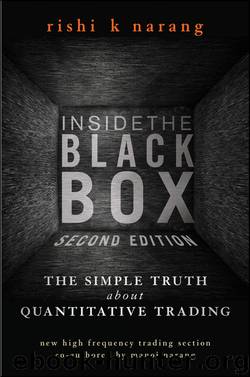Inside the Black Box by Rishi K. Narang

Author:Rishi K. Narang
Language: eng
Format: epub
ISBN: 9781118416990
Publisher: Wiley
Published: 2013-02-21T16:00:00+00:00
Average Rate of Return
The average rate of return indicates how well the strategy actually worked (i.e., how much it might have made) in the past. If it didn't work in the testing phase, it's very unlikely to work in real life. As we will see later, testing offers many opportunities for the researcher to believe that making money in trading is a trivially easy exercise. Sadly, this misperception is mainly due to a wide variety of deadly traps. In our S&P 500 example, the total cumulative profits in the simulation were 746 percent, which comes to an average annual rate of return of 12.1 percent before any transaction costs or fees.
Variability of Returns over Time
The variability of returns over time, which describes the uncertainty around the average returns, is helpful in deciding whether the strategy is worth owning. In general, the less the variability for a given level of returns, the better a strategy is considered to be. For example, if a strategy averages 20 percent returns per year, with an annual standard deviation of 2 percent (i.e., 67 percent of the time, the annual rate of return should fall within +/–2 percent of the average 20 percent figure, or between 18 and 22 percent), this would be a better outcome than if the same 20 percent average annual return came with 20 percent annual standard deviation (i.e., 67 percent of the time, returns are within 0 and 40 percent). The idea is that one can have more confidence in a given return if the uncertainty around it is low, and more confidence is a good thing.
At my shop, we look at a statistic we dubbed lumpiness, which is the portion of a strategy's total return that comes from periods that are significantly above average. This is another way of measuring consistency of returns. Despite the importance of this metric, it is not always the case that consistency should be a primary goal. Nevertheless, it is good to know what to expect as an investor in or practitioner of a strategy, if for no other reason than to discern when the strategy's behavior is changing. In our S&P 500 strategy, the annualized standard deviation of its daily returns over the entire test period was 21.2 percent.
Worst Peak-to-Valley Drawdown(s)
This metric measures the maximum decline from any cumulative peak in the profit curve. If a strategy makes 10 percent, then declines 15 percent, then makes another 15 percent, the total compounded return for this period is about +7.5 percent. However, the peak-to-valley drawdown is –15 percent. Another way of stating this is that the investor had to risk 15 percent to make 7.5 percent. The lower the drawdown of a strategy, the better. Many quants measure not just one drawdown but several, to get a sense of both the extreme and more routine downside historical risks of their strategies. It is also typical to measure recovery times after drawdowns, which give the researcher a sense of the model's behavior after it's done poorly.
Download
This site does not store any files on its server. We only index and link to content provided by other sites. Please contact the content providers to delete copyright contents if any and email us, we'll remove relevant links or contents immediately.
Rich Dad Poor Dad by Robert T. Kiyosaki(6174)
Pioneering Portfolio Management by David F. Swensen(6078)
How To Win Friends and Influence People by Dale Carnegie(4332)
The Money Culture by Michael Lewis(3846)
The Dhandho Investor by Mohnish Pabrai(3560)
The Wisdom of Finance by Mihir Desai(3523)
Liar's Poker by Michael Lewis(3220)
The Intelligent Investor by Benjamin Graham Jason Zweig(2930)
The ONE Thing by Gary Keller(2918)
Mastering Bitcoin: Programming the Open Blockchain by Andreas M. Antonopoulos(2890)
Fooled by Randomness: The Hidden Role of Chance in Life and in the Markets by Nassim Nicholas Taleb(2860)
Rich Dad Poor Dad: What The Rich Teach Their Kids About Money - That The Poor And Middle Class Do Not! by Robert T. Kiyosaki(2833)
How to Win Friends and Influence People by Dale Carnegie(2793)
Investing For Dummies by Eric Tyson(2791)
How to Day Trade for a Living: Tools, Tactics, Money Management, Discipline and Trading Psychology by Andrew Aziz(2784)
Market Wizards by Jack D. Schwager(2538)
Zero Hour by Harry S. Dent Jr. & Andrew Pancholi(2531)
How to Pay Zero Taxes, 2018 by Jeff A. Schnepper(2497)
Rich Dad's Guide to Investing by Robert T. Kiyosaki(2410)
